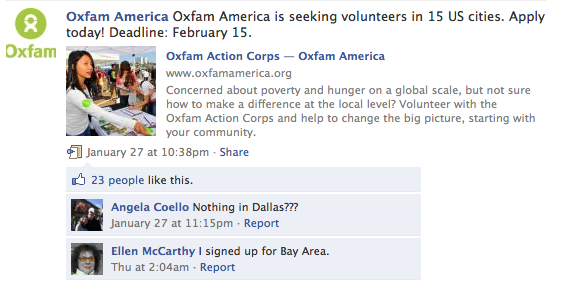 Interested in setting Facebook and Twitter benchmarks for your nonprofit but don’t know where to start? Check out M+R Strategic Services first Nonprofit Social Media Benchmarks Study, which includes sample research by groups such as Easter Seals, Oxfam, Human Rights Campaign, League of Conservation Voters, and more.
Interested in setting Facebook and Twitter benchmarks for your nonprofit but don’t know where to start? Check out M+R Strategic Services first Nonprofit Social Media Benchmarks Study, which includes sample research by groups such as Easter Seals, Oxfam, Human Rights Campaign, League of Conservation Voters, and more.
Facebook Key Findings:
- Organizations posted to their Facebook Pages about six times weekly.

- 2.5% of each organization's Facebook fans took some sort of an action weekly such as contributing wall posts, "likes," or comments.
- Generating a high fan rate is important, since news feeds carry that activity to potential new fans.
- Facebook fans grew by 3.75% monthly. However, it’s important to note that 2% of Facebook fans either removed themselves or chose to hide the news feed monthly.
- The overall fan churn rate is 24% per year, which is higher than the eNonprofit Benchmarks Study email churn rate of 19% per year.
Facebook Recommendations
- M+R recommends that nonprofits find their Facebook fans' "sweet spot" between too many and too few posts.
- Measure your organizations stats and engagement now and focus on improving those results over time.
- Engage and provide interesting and useful info to your fans.
Be sure and also check out Frogloop’s "Five Tips to Ramp Up Your Nonprofits Fan Page."
Twitter Key Findings
- Organizations tweeted four to five times daily.
- Twitter followers grew by 9% monthly, much higher than average monthly growth on both Facebook fan pages at 3.75% and nonprofit email lists at 1.4%.
- The more nonprofits were active on Twitter and tweeted, the more their followers retweeted their tweets which helped grow their Twitter following.
Twitter Recommendations:
While M+R did not provide a section on Twitter recommendations here are a couple of Frogloop's key suggestions to build up your organizations presence on Twitter.
Quality over Quantity
Don’t focus on getting millions of followers who may or may not care about your issue, but rather on people who are interested in the issues your organization is working on. In November 2009, Frogloop reported on a simple click-through rate test on a tweet and link that Beth Kanter sent out to her 120,000+ followers and Geoff Livingston sent to his 7500+ followers. The results? Beth’s link generated a 0.2% CTR and Geoff’s generated .7% CTR. Why? “Generally speaking, with more casual followers you lose engagement and influence power,” said Livingston.
Talk With Me Not At Me
Use Twitter to connect with your supporters and potential members. Don’t just tweet links to new articles, factsheets and call it a day. Twitter should be used as a two-way communication. Ask followers for their opinions on campaigns your organization is working on. Respond to their tweets. Counter the opposition publicizing bad information. Be social!
Also check out Frogloop’s post on The Art of Getting Retweeted.
You should follow Frogloop on Twitter.



COMMENTS